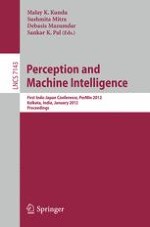2012 | Buch
Perception and Machine Intelligence
First Indo-Japan Conference, PerMIn 2012, Kolkata, India, January 12-13, 2012. Proceedings
herausgegeben von: Malay K. Kundu, Sushmita Mitra, Debasis Mazumdar, Sankar K. Pal
Verlag: Springer Berlin Heidelberg
Buchreihe : Lecture Notes in Computer Science
